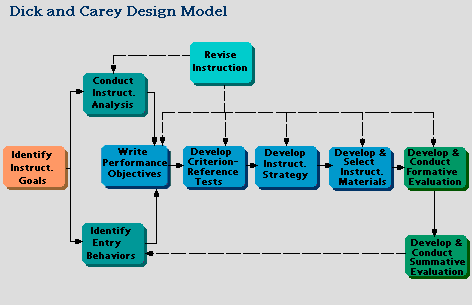Model for development of laboratory and classroom instructional materials
Project staff employ the Dick and Carey instructional materials development model (Dick, W. & Cary, L. 8th Ed. 2015) to develop activities. The development of each activity begins with the identification of an instructional goal or goals. Performance objectives are constructed for each goal that includes student entry behaviors and skills required for successful completion. Criterion-referenced assessment items are developed for each objective. Project staff review, select, and/or develop the most appropriate instructional strategies to accomplish the objective. A materials development cycle is followed by field tests of selected activities. Successive cycles of evaluation initiate revisions and lead to the final development of the materials.
An enhanced Dick and Carey protocol shape the laboratory protocols. The Baliga Group includes two additional steps prior to a field test. The first step is use of a scientist’s protocol by high school teachers. Teachers subsequently revise the protocol by incorporating their knowledge of the high school laboratory environment and their deep knowledge about students. The revised protocol undergoes cycles of testing and refinement until it reaches draft status. Draft status occurs when teachers are satisfied with its efficacy in the classroom. In the second step high school students complete the revised protocol while being observed by the teachers. Feedback from teachers and students are incorporated into the final protocol. The draft protocol is now ready for field-testing in selected classrooms.
The Baliga Group includes two additional steps prior to a field test. The first step is use of a scientist’s protocol by high school teachers. Teachers subsequently revise the protocol by incorporating their knowledge of the high school laboratory environment and their deep knowledge about students. The revised protocol undergoes cycles of testing and refinement until it reaches draft status. Draft status occurs when teachers are satisfied with its efficacy in the classroom. In the second step high school students complete the revised protocol while being observed by the teachers. Feedback from teachers and students are incorporated into the final protocol. The draft protocol is now ready for field-testing in selected classrooms.
A third review of the draft materials is accomplished during professional development workshops where teachers are newly introduced to the materials. Project staff model each activity for classroom teachers. The classroom teachers experience the activities from their students’ viewpoint and provide feedback about their effectiveness. Any needed revisions are completed prior to implementation in classrooms.
Project staff devote particular attention to teachers’ conceptual development during the workshop. The materials contain relatively new or advanced ideas and techniques and necessitate instructional sessions on biological networks; informatics and systems approach to biological research. Content updates are presented for classroom teachers during the workshop. Teachers’ up to date conceptual understanding of today’s biology impacts contributes to effective use of the new instructional materials with their students.
Instructional Materials Design Specifications
The project’s partners have designed instructional materials to satisfy Next Generation Science Standards, Common Core, and to develop 21st Century Skills. See each individual lesson plan and our module overviews for detailed information. These can be found from our main Module Page. Or see our Standards Addressed page for more information. All lessons integrate today’s science and engineering practices, crosscutting concepts, disciplinary core ideas, and connected skills for multi-dimensional learning that is rigorous and hands-on.
The modules are free for all to use online. Coding the instructional activities, teacher’s guide, assessment and instructional masters in html format and editable files results in an electronic textbook, facilitates revisions and dissemination. Please see our Module Page to access all instructional activities.
